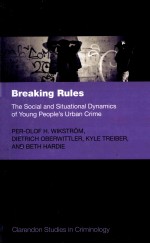

BREAKING RULESPDF电子书下载
- 电子书积分:15 积分如何计算积分?
- 作 者:PER-OLOF H.WIKSTROM
- 出 版 社:OXFORD UNIVERSITY PRESS
- 出版年份:2012
- ISBN:0199592845
- 页数:479 页
Part 1 Analysing Crime as Situational Action: Theory, Methods, Key Constructs, and Basic Findings 3
1. Situational Action Theory 3
1.1 Criminology: A fragmented and poorly integrated discipline 3
1.2 Key common shortcomings in criminological theory 7
1.3 Situational Action Theory: Basic constructs and propositions 11
1.4 Situational Action Theory: The causes of the causes 29
1.5 Explaining urban crime patterns 41
2. The Peterborough Adolescent and Young Adult Development Study 44
2.1 The research design 44
2.2 The cohort study 53
2.3 Parents' interviews 61
2.4 Young people's interviews 62
2.5 Space-time budget 67
2.6 Criminal justice records data 78
2.7 Data quality 82
2.8 Small area community survey (PCS) 87
2.9 Summary and conclusion 104
3. Young People's Crime, Crime Propensity, and Criminogenic Exposure: Key Constructs and Basic Findings 107
3.1 Crime 107
3.2 Crime propensity 132
3.3 Criminogenic exposure 141
3.4 Predicting crime involvement: The interaction between crime propensity and criminogenic exposure 155
3.5 Summary and conclusion 155
Part 2 The Social Dynamics of Young People's Urban Crime 161
4. Peterborough, Its Urban Structure, and Crime 161
4.1 Peterborough: The research site 162
4.2 Land use 167
4.3 Residential segregation 171
4.4 Area patterns of crime and disorder 186
4.5 Modelling population structure, collective efficacy, land use, and crime events 200
4.6 Summary and conclusion 206
5. Young Offenders and Their Crimes in the Urban Environment 209
5.1 Area patterns of young people's crime 211
5.2 Modelling the distribution of young people's crime 219
5.3 Offender home locations 222
5.4 Modelling the distribution of young offenders 236
5.5 Crime and distance 239
5.6 Summary and conclusion 250
6. Young People, Their Activities, and Criminogenic Exposure 252
6.1 Young people's activity patterns 252
6.2 Settings and circumstances of criminogenic exposure 277
6.3 Social sources of young people's criminogenic exposure 299
6.4 Differential effects of criminogenic exposure by young people's crime propensity 311
6.5 Explaining the variation in area concentrations of young people's crime 312
6.6 Summary and conclusion 319
Part 3 The Situational Dynamics of Young People's Crime 323
7. The Crime Convergence: Kinds of People in Kinds of Settings 323
7.1 Studying the intersection of people and settings 323
7.2 Distribution of space-time budget crimes 323
7.3 Exposure to criminogenic settings and crime involvement by crime propensity 347
7.4 Summary and conclusions 363
8. Choosing Crime as an Alternative: Crime Propensity, The Perception-Choice Process, and Crime 364
8.1 Capturing the perception-choice process: A factorial survey approach 367
8.2 PADS+ randomized scenarios 369
8.3 Scenario findings 380
8.4 Hypothetical scenarios and the real world 393
8.5 Summary and conclusion 402
Part 4 The Dynamics of Rule-Breaking: Key Findings 405
9. It's All About Interactions 405
9.1 Breaking rules 405
9.2 It's all about interactions 406
Appendices 411
A1 Technical Appendix 413
A1.1 Calculating distance 413
A1.2 Presentation of spatial data 413
A1.3 Controlling for resident young people 419
A1.4 Quantifying time use 421
A2 Space-Time Budget Coding Appendix 423
A2.1 Activity 424
A2.2 Place 427
A2.3 With whom 430
A2.4 Extra incidents 433
References 437
Index 467
- 《中国“80后”大学教师胜任力评价研究=RESEARCH ON THE EVALUATION OF CHINA'S POST 80s GENERATION UNIVERSITY TEACHERS' CO》黄艳著 2013
- 《解读好莱坞:电影的空间与意义》Deborah Thomas著;李达义,曹玉玲译 2004
- 《会说话的星图 星座篇》徐历涛著 2014
- 《可靠性工程与风险管理 第3辑 英文版》赵衍刚编 2012
- 《竞争战略 全译珍藏版》(美)迈克尔·波特(Michael E. Porter)著 2012
- 《中国材料名师讲坛 第1辑》谢建新主编 2012
- 《翻译能力的培养》舍夫娜,阿达巴编 2012
- 《大学生外语口语焦虑 自我图式的视角 for university students: in the view of self-schema》巫文胜著 2014
- 《都柏林大学的教育内涵与实践 探索世界高水平大学发展之路 explore the development of the world high-level university》李全宏编著 2013
- 《物理学 卷1 力学和热学 医学、生物等专业适用 英文改编版原书第4版》AlanGiambattista,BettyMcCarthyRichardson著 2013
